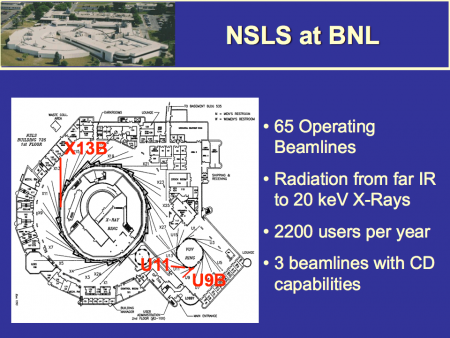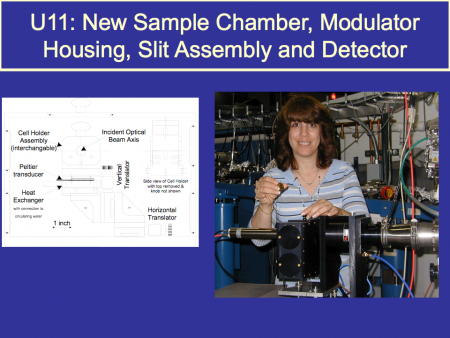As John developed the instrumentation for synchrotron radiation circular dichroism (SRCD) spectroscopy, the technique gained popularity among researchers studying biological molecules. John continued collaborating with Betsy on UV-induced DNA damage, while also inventing instruments with new capabilities.
Bonnie Ann Wallace was an assistant professor at Columbia University when she met John in 1982. At the time, she was using circular dichroism (CD) spectroscopy to examine protein structures, and John had just completed a second beamline, U11, at Brookhaven. When she heard about John’s synchrotron radiation (SR) light source for CD, she asked to use it to examine her samples. “I believe my student and I became John’s first external users of his beamline, back in 1983,” says Wallace, now a professor of molecular biophysics at Birkbeck College, University of London.
Since then, Wallace had worked with John on SRCD. They were co-directors of workshops on applications of SRCD, described in Synchrotron Radiation News.
John was the first to use SRCD to look at biological samples of nucleic acids, Wallace notes. It was a natural tie-in with Betsy’s work on damage and repair of nucleic acids.
“John built the SRCD instruments in Brookhaven,” Wallace says. “There are currently around a dozen around the world – in Denmark, Germany, France, England, China, Taiwan, Japan – sadly none in America anymore. When John retired, they closed the one at Brookhaven because there wasn’t anyone with expertise to carry on operating it.”
No company makes SRCD instruments. “They are being built by scientists around the world,” Wallace says. “I have helped advise and design a number of these instruments, but they are based on the instrumentation John initially built at Brookhaven.”
“We were complementary,” Wallace says about working closely with John on SRCD. “I would develop biological questions that could be answered by SRCD and then initially we would take samples to Brookhaven and make measurements. Sometimes what we did on the instrument gave feedback, and much of our early work was on enabling studies for the technique. We would sit and talk about it afterward. And John would make changes to the instrumentation so that we could make the measurement that we thought would be most valuable. Now we undertake our studies at beamlines around the world.”
Wallace’s husband – Robert W. Janes, a senior lecturer at Queen Mary College, University of London – also works in an area of CD spectroscopy and has known John for many years. “We have a long-standing and great fondness for John,” she says.
As John developed the instrumentation for synchrotron radiation circular dichroism (SRCD) spectroscopy, the technique gained popularity among researchers studying biological molecules. John continued collaborating with Betsy on UV-induced DNA damage, while also inventing instruments with new capabilities.
Bonnie Ann Wallace was an assistant professor at Columbia University when she met John in 1982. At the time, she was using circular dichroism (CD) spectroscopy to examine protein structures, and John had just completed a second beamline, U11, at Brookhaven. When she heard about John’s synchrotron radiation (SR) light source for CD, she asked to use it to examine her samples. “I believe my student and I became John’s first external users of his beamline, back in 1983,” says Wallace, now a professor of molecular biophysics at Birkbeck College, University of London.
Since then, Wallace had worked with John on SRCD. They were co-directors of workshops on applications of SRCD, described in Synchrotron Radiation News.
John was the first to use SRCD to look at biological samples of nucleic acids, Wallace notes. It was a natural tie-in with Betsy’s work on damage and repair of nucleic acids.
“John built the SRCD instruments in Brookhaven,” Wallace says. “There are currently around a dozen around the world – in Denmark, Germany, France, England, China, Taiwan, Japan – sadly none in America anymore. When John retired, they closed the one at Brookhaven because there wasn’t anyone with expertise to carry on operating it.”
Whenever there’s a technical question, my answer is always: Ask John Sutherland. I just completely trust his knowledge of the physics.
No company makes SRCD instruments. “They are being built by scientists around the world,” Wallace says. “I have helped advise and design a number of these instruments, but they are based on the instrumentation John initially built at Brookhaven.”
“We were complementary,” Wallace says about working closely with John on SRCD. “I would develop biological questions that could be answered by SRCD and then initially we would take samples to Brookhaven and make measurements. Sometimes what we did on the instrument gave feedback, and much of our early work was on enabling studies for the technique. We would sit and talk about it afterward. And John would make changes to the instrumentation so that we could make the measurement that we thought would be most valuable. Now we undertake our studies at beamlines around the world.”
Wallace’s husband – Robert W. Janes, a senior lecturer at Queen Mary College, University of London – also works in CD spectroscopy and has known John for many years. “We have a long-standing and great fondness for John,” Wallace says.
John is first and foremost a gentleman in his life and his work. He is a thorough and clever physical scientist with a shrewd understanding of the importance of physics for biology. His focus has been on the technical side, but he has not forgotten that applications are what excite the rest of the scientific world.
PUBLICATIONS


